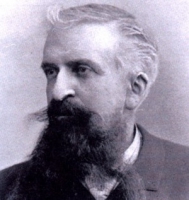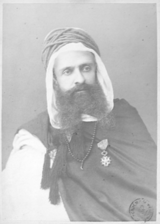| |
古斯塔夫·勒邦(法語:Gustave Le Bon;1841年5月7日-1931年12月13日)是一位法國社會心理學家、社會學家,以其對於群體心理的研究而聞名,被後人譽為“群體社會的馬基雅維利”。勒邦認為,在群體之中,個體的人性就會湮沒、獨立的思考能力也會喪失,群體的精神會取代個體的精神。
勒邦最出名的作品是1895年出版的《烏合之衆:大衆心理研究》,該作品被認為是群衆心理學領域的開創性作品。該書已被翻譯為近20種語言。
勒邦出生於法國厄爾-盧瓦省諾讓勒羅特魯,1866年於巴黎大學取得了醫學士學位。畢業後他沒有選擇成為一名醫生,而是選擇開始他的寫作生涯。他在畢業後出版了一係列的醫學文章和書籍。勒邦於普法戰爭爆發後參加了法國陸軍,見證了法國軍隊的戰敗和巴黎公社的整個過程,這強烈地塑造了勒邦的世界觀。在這之後,勒邦開始廣泛地遊歷,走遍了歐洲、亞洲和北非。他在遊歷過程中研究人類和文明,逐漸産生了一種對人性的本質主義看法,並在遊歷過程中發明了一種便攜式的頭部測量儀。
在19世紀90年代,他轉嚮心理學和社會學,並在這些領域發表了大量他最成功的作品。勒邦提出了一種觀點,即人群不是他們各自個體的總和,而是形成了一個新的心理學主體,這個主體的性格特徵由人群的“集體潛意識”决定。在這段時間內,他創造了自己的心理學和社會學理論,並在物理學方面進行了一係列實驗,並出版了相關研究主題的流行書籍,預見了質能方程(E = mc²)和核子時代。勒邦在他1931年去世之前都保持着這樣廣泛的興趣。
由於勒邦在政治上的保守主義和反動的觀點,他一直被法國學術和科研機構忽視和誹謗。勒邦對民主制度和社會主義持有批評(critical)態度。
生平
幼年
古斯塔夫·勒邦於1841年5月7日出生於法國中央-盧瓦爾河𠔌大區諾讓勒羅特魯一個布列塔尼傢族。在他出生時,他的母親 Annette Josephine Eugénic Tétiot Desmarlinais 26歲,而他的父親 Jean-Marie Charles Le Bon 41歲,是一名省政府的公職人員。 勒邦是 Jean-Odet Carnot 的直係後裔,Jean-Odet Carnot 的祖父 Jean Carnot 有一個兄弟 Denys,是法蘭西第三共和國的第五任總統瑪利·弗朗索瓦·薩迪·卡諾的直係祖先。
當勒邦八歲時,他的父親在法國政府獲得了一個新職位,帶着傢人,包括勒邦的弟弟喬治,離開了諾讓勒羅特魯,再也沒有回到這個小鎮。儘管如此,小鎮對於古斯塔夫·勒邦的出生仍然很自豪,後來以他的名字命名了一條街道。 人們對勒邦的童年知之甚少,除了他曾是安德爾-盧瓦爾省省會圖爾的一名普通中學生。
勒邦自1860年起在巴黎大學學習醫學,於1866年在Hôtel-Dieu de Paris醫院完成實習並取得博士學位。在那之後,他開始稱呼自己為醫生,儘管他從來沒有從事過此職業。在大學期間,勒邦撰寫了一係列關於醫學主題的論文,其中第一篇是關於那些生活在沼澤地的人的疾病。後來,他又發表了一係列關於羅阿羅阿絲蟲和窒息的論文。勒邦在1866年出版了他的第一本完整的書籍,“Apparent Death and Premature Burials”(法語:La mort apparente et inhumations prématurées,1866年),這本書籍主要討論了關於死亡的定義,早於20世紀法律意義上的死亡的相關討論。
巴黎生活
畢業之後,勒邦繼續留在了巴黎,通過閱讀各種語言的莎士比亞作品自學英語和德語。在這期間勒邦一直保持着研究的熱情,撰寫了數篇關於生理學研究的論文,甚至包括1868年一本關於有性生殖的教科書。在1870年7月普法戰爭爆發後,勒邦加入了法國陸軍並成為一名軍醫。在戰爭期間,勒邦組織了一個軍用救護車部門。在這種情況下,他註意到了軍隊在最壞的情況(完全戰敗)下的行為,並寫下了他關於人在壓力與痛苦下的軍事紀律、領導能力與行為方面的反思。這些反思獲得了將軍們的贊揚,後來被法國聖西爾軍校和其他軍事院校繼續研究。在戰爭結束時,勒邦獲得了法國榮譽軍團勳章的騎士勳位。
勒邦還見證了1871年的巴黎公社,這深刻影響了他的世界觀。當時三十歲的勒邦看着巴黎革命人群燒毀了杜伊勒裏宮,盧浮宮圖書館,巴黎市政廳,戈布蘭挂毯工廠,巴黎司法宮以及其他不可替代的建築藝術作品。
從1871年開始,勒邦成為了社會主義、和平主義和貿易保護主義的公開反對者,他認為這些主義在阻礙法國的軍事發展和工業增長。勒邦在1913年表示:“衹有擁有大炮的人,纔有權利成為和平主義者。”他還警告他的同胞,面對德國的軍事力量和迅速的工業化,政治對抗的有害影響;因此沒有受到引起法國動蕩的德雷福斯事件的影響。
廣泛的遊歷
勒邦於19世紀70年代開始對新興的人類學領域感興趣,並開始遊歷歐洲、亞洲和北非。受到查爾斯·達爾文、赫伯特·斯賓塞和恩斯特·海剋爾的影響,勒邦支持生物决定論以及對種族和性別的等級觀點;經過廣泛的實地研究,他在顱骨容量和智力的關聯性上提出了一個假設,並在1879年寫下了“Anatomical and mathematical research on the changes in brain volume and its relationships with intelligence"(法語:Recherches anatomiques et mathématiques sur les variations de volume du cerveau et sur leurs relations avec l'intelligence,1879年),獲得了法國科學院的 the Godard Prize。在研究期間,他發明了一種便攜式頭部測量儀,以幫助測量偏遠民族的身體特徵,並於1881年發表了一篇論文“The Pocket Cephalometer, or Compass of Coordinates”,詳細介紹了他的發明及其應用。
1884年,勒邦受法國政府的委托,到亞洲遊歷並就那裏的文明作報告。 這次遊歷結束後他寫作了一係列書籍,並産生了一種思想,認為文化主要受到遺傳因素的影響,例如人們獨特的種族特徵。 第一本書出版於1884年,名為“The World of Islamic Civilization”(法語:La Civilisation des Arabes,1884年)。在書中他高度贊揚阿拉伯人對文明的貢獻,但是批評伊斯蘭主義是(文明發展)停滯的原因。 他在書中還描述了阿拉伯文化優於管理他們的土耳其人(奧斯曼帝國、奧斯曼土耳其人)的文化,這本書的翻譯鼓勵了早期的阿拉伯民族主義者。 他隨後前往尼泊爾,成為第一位訪問該國的法國人,並於1886年出版了“Travel to Nepal”(法語:Voyage au Népal,1886年)。
接下來,勒邦於1887年出版了“The Civilisations of India”(法語:Les Civilisations de l'Inde,1887年),在書中他贊揚了印度的建築、藝術和宗教,但認為印度人在科學進步方面相對於歐洲人處於劣勢,這對英國人的統治提供了便利。 在1889年,他發佈了“The First Civilisations of the Orient”(法語:Les Premières Civilisations de l'Orient,1889年),介紹了美索不達米亞、印度、中國和埃及文明。同年,他嚮國際殖民大會發表演講,批評殖民政策,其中包括文化同化的嘗試,並說:“讓當地人保留他們的風俗、習慣和法律。” 勒邦在1893年出版了他關於他遊歷的最後一本書,“The Monuments of India”(法語:Les Monuments de l'Inde,1893年),再次稱贊了印度人民在建築領域取得的成就。
理論的發展
在旅行中,勒邦主要依靠馬匹,他註意到每個地區的馬匹飼養員與訓練員所使用的方法都不一樣。當他1892年返回巴黎時,他興奮的馬甩下馬背,差點去世。他不確定是什麽原因導致了他被馬甩下來,並决定開始研究原因。 他將研究結果寫成了“Equitation: The Psychology of the Horse”(法語:L'Équitation actuelle et ses principes. Recherches expérimentales,1892年),其中包括大量的馬匹照片以及勒邦的分析。這項成果後來成為了一部受重視的騎馬指南。此外,勒邦將他對馬匹的研究成果外推,用到了學前教育領域。
勒邦對馬的行為研究也引發了人們對心理學的長期興趣,並於1894年發佈了“The Psychology of Peoples”(法語:Les Lois Psychologiques de l'Évolution des Peuples,1894年),他將這本書獻給他的朋友夏爾·羅貝爾·裏歇,儘管他參考了不少Théodule-Armand Ribot的理論。隨後,他將另一本書獻給了 Ribot,就是著名的《烏合之衆:大衆心理研究》(英語:The Crowd: A Study of the Popular Mind,法語:Psychologie des Foules,1895年)。這本書中包含了勒邦在1881年的作品“Man and Society”(法語:L'Homme et les sociétés,1881年),而1881年的這部作品被社會學三大奠基人愛米爾·塗爾幹在他的博士學位論文社會分工論(法語:The Division of Labour in Society)中引用。
這幾本書都成為了暢銷書,《烏合之衆:大衆心理研究》更是在出版一年內就被翻譯成了19種語言。 隨後勒邦又出版了兩本心理學相關書籍,分別是:“The Psychology of Socialism”(法語:Psychologie du Socialisme,1896年)和“The Psychology of Education”(法語:Psychologie de l'éducation,1902年)。這些作品在很大程度上激怒了法國的社會主義學術機構。
勒邦在19世紀90年代早期建造了一個家庭實驗室,並於1896年報告觀察到了“黑光”,他認為這種新的輻射與X射綫和陰極射綫不同,但可能又有關聯。 與現在所知的黑光不同,勒邦當時報告的黑光的存在從未得到證實,這與N射綫相似。現在人們普遍認為它不存在,但這一發現在當時引起了法國科學家們的極大關註,他們中的許多人都贊同勒邦在物質和輻射上的一般觀點,勒邦甚至在1903年被提名諾貝爾物理學奬。
1902年勒邦開始舉行一係列的每周午餐會,邀請了知名的知識分子,貴族和時尚女士。他的人脈廣泛,賓客名單包括:數學家儒勒·昂利·龐加萊、法蘭西第三共和國總統雷蒙·普恩加萊堂兄弟、法國作傢與詩人保羅·瓦勒裏、俄國外交官亞歷山大·伊茲沃爾斯基(Alexander Petrovich Izvolsky)、法國哲學家亨利·柏格森、法國化學家馬塞蘭·貝特洛、法國政治傢阿裏斯蒂德·白裏安。
在1905年發表的自然科學著作“The Evolution of Matter”(法語:L'Évolution de la Matière)中,勒邦預見了質能方程(E = mc²)的存在。後來在1922年他寫給愛因斯坦的一封信中,他抱怨自己沒有獲得認可。愛因斯坦回應並承認,在他之前質能方程已經被提出,但衹有相對論證明了這一理論。 兩年後,勒邦在“The Evolution of Forces”(法語:L'Évolution des Forces,1907年)中預言了核子時代。 他在書中闡述:“新能量的表現形式,即原子能,以其巨大的規模超過其它所有能量。”他表示,如果有科學家找到了能迅速將一剋任何金屬離解的方法,那麽他將“看不到他自己的實驗結果,實驗産生的巨大爆炸是如此的強大,會將他的實驗室和周圍的房屋及居民立刻撕碎”。
勒邦在1908年停止了在物理學方面的研究,並再次轉回心理學。他在1910年到1914年期間連續出版了“The Psychology of Politics and Social Defense”(法語:La Psychologie politique et la défense sociale,1910年)、“Opinions and Beliefs”(法語:Les Opinions et les croyances,1911年)、“The Psychology of Revolution”(法語:La Révolution Française et la Psychologie des Révolutions,1912年)、“Aphorisms of Present Times”(法語:Aphorismes du temps présent,1913年)、“Truths of Life”(法語:La Vie des vérités,1914年),在這些作品中闡述了他對感性和理性、種族心理學和文明史的看法。
晚年生活與逝世
勒邦在第一次世界大戰期間堅持寫作,在戰爭期間出版了“The Psychology of the Great War”(法語:Enseignements Psychologiques de la Guerre Européenne,1915年)、“First Consequences of War: Mental Transformation of Peoples”(法語:Premières conséquences de la guerre: transformation mentale des peuples,1916年)和“Yesterday and Tomorrow. Brief thoughts”(法語:Hier et demain. Pensées brèves,1918年)。
隨後,他出版了“The World in Revolt”(法語:Psychologie des Temps Nouveaux,1920年),然後他辭去了在巴黎大學的心理學和相關科學的教授職務,並退休回傢。
後來,他在1923年、1924年和1927年連續出版了“The World Unbalanced”(法語:Le Déséquilibre du Monde,1923年)、“The Uncertainties of the Present Hour”(法語:Les Incertitudes de l'heure présente,1924年)和“The Current Evolution of the World, Illusions and Realities”(法語:L'évolution actuelle du monde, illusions et réalités,1927年),在書中表達了他對不穩定的戰間期世界的看法。
勒邦在1929年獲得了法國榮譽軍團勳章的大十字勳位,在1931年出版了他的最後一部作品,“Scientific Basis for a Philosophy of History”(法語:Bases scientifiques d'une philosophie de l'histoire,1931年)。同年12月13日,勒邦逝世於法國法蘭西島馬爾訥拉科凱特,享年90歲。
勒龐的學說
| 此章節需要擴充。 (2019年7月1日) |
勒龐深信人類的行為受到永恆的法律的引導,並試圖綜合奧古斯特·孔德、赫伯特·斯賓塞、儒勒·米什萊、亞歷西斯·德·托剋維爾的思想。
靈感
根據Steve Reicher的說法,勒龐並不是第一個群衆心理學家,他說:“群衆心理學的第一場討論的雙方是兩個犯罪學家,Scipio Sighele和加布裏埃爾·塔爾德,關於如何在人群中查明和確定刑事責任,從而决定逮捕誰。” 雖然之前的討論可能是合理的,但值得指出的是,勒龐指出群衆的影響不僅是負面現象,而且還可能産生積極影響。他認為這衹是那些衹考慮群衆心理學犯罪方面的作者的缺點。
群衆
勒龐理論認為,新的實體,即“心理人群”,從融合的群體中産生,不僅形成了一個新的實體,而且還創造了一個集體的潛意識。當許多人湊到一起並形成一個群體時,會有一種群體發出的仿佛有磁性的影響,改變了每一個個體的行為,直到個體被所謂的“集體錯覺”所支配。這種模式將群體看成一個整體,在內部剝奪了每一個個體成員的意見、價值觀和信仰。正如勒龐所說:“群體中的人不過是塵沙中的一粒微粒,他們衹能是任憑無意識的激潮吹拂席捲,把他們帶到任何一個地方。”
勒龐列舉了創造群衆心理的三個關鍵特徵:匿名性、傳染性和暗示。匿名性為一個理性的個體提供了一種不可戰勝的感覺,並導致個體責任感的喪失,使得個體變得原始、無理和情緒化。自我剋製的缺乏使得個體屈服於本能,接受“集體潛意識”的控製。對勒龐來說,群體顛覆了達爾文進化論而産生了返祖現象,證明了恩斯特·海剋爾的胚胎學理論——胚胎重演律 Ontogeny recapitulates phylogeny。 傳染是指人群中特定行為的傳播,個人為了集體利益而犧牲個人利益。暗示是實現傳染的機製,當人群凝聚成一個單一的思想時,人群中強烈的聲音所提出的建議為集體潛意識的出現創造了空間,並將引導整個集體的行為。在這個階段,群衆心裏變得同質化,並容易受到其中最強大成員的建議的影響。“我們所說的領導,”勒龐說:“通常是實幹傢而不是思想傢。他們沒有敏銳的遠見天賦,他們也不可能有,因為這樣的天賦通常會導致懷疑和不作為。他們尤其喜歡從那些病態神經質、容易激動、半精神錯亂、在瘋狂邊緣的的人群中招募新成員。”
The leaders we speak of are more frequently men of action than thinkers. They are not gifted with keen foresight, nor could they be, as this quality generally conduces to doubt and inactivity. They are especially recruited from the ranks of those morbidly nervous, excitable, half-deranged persons who are bordering on madness.
作品
Bibliography compiled from the 1984 reissue of Psychologie du Socialisme.
醫學
- La mort apparente et inhumations prématurées (1866); ("Apparent Death and Premature Burials")
- Traité pratique des maladies des organes génitaux-urinaires (1869); ("Practical Treatise of Diseases of the Genitourinary System")
- La vie (Traité de physiologie humaine) (1874); ("Life (Treatise of Human Physiology)")
人類學、心理學和社會學
- Histoire des origines et du développement de l'homme et des sociétés (1877); ("History of the Origins and Development of Man and Society")
- Voyage aux Monts-Tatras (1881); ("Travel to Tatra Mountains")
- L'Homme et les sociétés (1881); ("Man and Society")
- La Civilisation des Arabes (1884); The World of Islamic Civilization (1974)
- Voyage au Népal (1886); ("Travel to Nepal")
- Les Civilisations de l'Inde (1887); ("The Civilisations of India")
- Les Premières Civilisations de l'Orient (1889); ("The First Civilisations of the Orient")
- Les Monuments de l'Inde (1893); ("The Monuments of India")
- Les Lois Psychologiques de l'Évolution des Peuples (1894); The Psychology of Peoples (1898)
- Psychologie des Foules (1895); The Crowd: A Study of the Popular Mind (1896)
- Psychologie du Socialisme (1896); The Psychology of Socialism (1899)
- Psychologie de l'éducation (1902); ("The Psychology of Education")
- La Psychologie politique et la défense sociale (1910); ("The Psychology of Politics and Social Defense")
- Les Opinions et les croyances (1911); ("Opinions and Beliefs")
- La Révolution Française et la Psychologie des Révolutions (1912); The Psychology of Revolution (1913); The French Revolution and the Psychology of Revolution (1980).
- Aphorismes du temps présent (1913); ("Aphorisms of Present Times")
- La Vie des vérités (1914); ("Truths of Life")
- Enseignements Psychologiques de la Guerre Européenne (1915); The Psychology of the Great War (1916)
- Premières conséquences de la guerre: transformation mentale des peuples (1916); ("First Consequences of War: Mental Transformation of Peoples")
- Hier et demain. Pensées brèves (1918); ("Yesterday and Tomorrow. Brief thoughts")
- Psychologie des Temps Nouveaux (1920); The World in Revolt (1921)
- Le Déséquilibre du Monde (1923); The World Unbalanced (1924)
- Les Incertitudes de l'heure présente (1924); ("The Uncertainties of the Present Hour")
- L'évolution actuelle du monde, illusions et réalités (1927); ("The Current Evolution of the World, Illusions and Realities")
- Bases scientifiques d'une philosophie de l'histoire (1931); ("Scientific Basis for a Philosophy of History")
自然科學
- La Méthode graphique et les appareils enregistreurs (1878); ("The Graphical Method and recording devices")
- Recherches anatomiques et mathématiques sur les variations de volume du cerveau et sur leurs relations avec l'intelligence (1879); ("Anatomical and mathematical research on the changes in brain volume and its relationships with intelligence")
- La Fumée du tabac (1880); ("Tobacco smoke")
- Les Levers photographiques (1888); ("Photographic surveying")
- L'Équitation actuelle et ses principes. Recherches expérimentales (1892); ("Equitation: The Psychology of the Horse")
- L'Évolution de la Matière (1905); The Evolution of Matter (1907)
- La naissance et l'évanouissement de la matière (1907); ("The birth and disappearance of matter")
- L'Évolution des Forces (1907); The Evolution of Forces (1908)
影響
| 此章節需要擴充。 (2019年7月1日) |
格爾奧格·摩瑟聲稱,20世紀20年代出現的法西斯領導理論很大程度上歸功於勒邦的群衆心理學理論。衆所周知阿道夫·希特勒讀過《烏合之衆》,並在《我的奮鬥》中藉鑒了勒邦的宣傳技巧。 貝尼托·墨索裏尼也對勒邦的學說進行了大量的研究。 此外,勒邦的學說也影響了弗拉基米爾·列寧和布爾什維剋。
就在第一次世界大戰之前,威爾弗雷德·特羅特(Wilfred Trotter) 威爾弗雷德·比昂(Wilfred Bion)介紹了勒邦的著作,以及弗洛伊德的作品《群體心理學與自我的分析》。特羅特的作品《和平與戰爭中民衆的本能》(英語:Instincts of the Herd in Peace and War ,1919年)構成了比昂和歐內斯特·瓊斯的研究的基礎,他們在後來創立了群體動力學。在二十世紀上半葉,勒邦的著作被哈德利·坎特裏爾和赫伯特·布魯默等媒體研究人員用來描述隸屬群體對媒體的反應。
“公共關係之父”愛德華·伯內斯,弗洛伊德的外甥,也受到了勒邦和特羅特的影響。在他的著作宣傳中,他宣稱民主的一個主要特徵是大衆媒體和廣告對選民的操縱。西奧多·羅斯福以及查爾斯·蓋茨·道威斯和20世紀初的許多其他美國進步人士也深受勒邦的著作影響。
參考來源
- ^ G.勒邦. (原始內容存檔於2010-03-05).
- ^ Rancière, Jacques. The Method of Equality: Interviews with Laurent Jeanpierre and Dork Zabunyan. Polity. 2016: 95. ISBN 978-0745680620.
- ^ Drury, John; Scott, Clifford. Crowds in the 21st Century: Perspectives from Contemporary Social Science. Routledge. 2015: 169. ISBN 978-1138922914.
- ^ Adas, Michael. Machines as the Measure of Men: Science, Technology, and Ideologies of Western Dominance. Cornell University Press. 1990: 195. ISBN 9780801497605.
- ^ 5.0 5.1 Widener 1979,第25頁
- ^ van Ginneken 1992,第132頁
- ^ Widener 1979,第26頁
- ^ Widener 1979,第21頁
- ^ 9.0 9.1 Staff writer(s). Gustave Le Bon. Nature. 10 May 1941: 573.
- ^ Widener 1979,第27頁
- ^ 11.0 11.1 Widener 1979,第28頁
- ^ Le Bon, Gustave. Aphorismes du temps présent. Ernest Flammarion. 1913.
- ^ Staum 2011,第65頁
- ^ Bud, Robert; Warner, Deborah Jean. Instruments of Science: An Historical Encyclopedia. Taylor & Francis. 1998: 157. ISBN 9780815315612.
- ^ Söyler, Mehtap. The Turkish Deep State: State Consolidation, Civil-Military Relations and Democracy. Routledge. 2015: 70. ISBN 9781317668800.
- ^ Mitter, Partha. Much Maligned Monsters: A History of European Reactions to Indian Art. University of Chicago Press. 1992: 268. ISBN 9780226532394.
- ^ Quinn, Frederick. The Sum of All Heresies: The Image of Islam in Western Thought. Oxford University Press. 2007: 104. ISBN 9780199886760.
- ^ Hourani, Albert. Arabic Thought in the Liberal Age 1798-1939. Cambridge University Press. 1962: 173. ISBN 9780521274234.
- ^ Kedourie, Sylvia. Arab Nationalism: An Anthology. Cambridge University Press. 1962: 182. ISBN 9780520026452.
- ^ Kramer, Martin Seth. Arab Awakening and Islamic Revival: The Politics of Ideas in the Middle East. Transaction Publishers. 2011: 63. ISBN 9781412817394.
- ^ Carey, John. The Intellectuals and the Masses: Pride and Prejudice Among the Literary Intelligentsia 1880-1939. Faber & Faber. 2012: 31. ISBN 9780571265107.
- ^ Seymore, Sarah. Close Encounters of the Invasive Kind: Imperial History in Selected British Novels of Alien-Encounter Science Fiction After World War II. LIT Verlag Münster. 2013: 108. ISBN 9783643903914.
- ^ Betts 1960,第68頁
- ^ Sills, David L. International Encyclopedia of the Social Sciences. Macmillan. 1968: 82. ISBN 9780028661520.
- ^ Widener 1979,第14頁
- ^ Widener 1979,第15頁
- ^ van Ginneken 1992,第172頁
- ^ Wagner, Gerhard. Who's Afraid of "Dr. Le Bon"?. Sociological Theory (American Sociological Association). November 1993: 321–323.
- ^ Ewen, Stuart; Ewen, Elizabeth. Typecasting: On the Arts and Sciences of Human Inequality. Seven Stories Press. 2011: 346. ISBN 9781583229491.
- ^ Nye, Robert A. An Intellectual Portrait of Gustave Le Bon: A Study of the Development and Impact of the Social Scientist in His Historical Setting. Xerox University Microfilms. 1969: 5.
- ^ Nye, Mary. Gustave Le Bon’s Black Light: A Study in Physics and Philosophy in France at the Turn of the Century. 1974: 163–195.
- ^ Kragh, Helge. Quantum Generations: A History of Physics in the Twentieth Century. Princeton University Press. 1999: 11–12.
- ^ Betts 1960,第65頁
- ^ Jammer, Max. Concepts of Mass in Contemporary Physics and Philosophy. Princeton University Press. 2009: 72. ISBN 9781400823789.
- ^ Widener 1979,第13頁
- ^ Crosland, Maurice. Science Under Control: The French Academy of Sciences 1795-1914. Cambridge University Press. 2002: 347.
- ^ Widener 1979,第19頁
- ^ Kayman, Martin A. Modernism Of Ezra Pound: The Science Of Poetry. Springer. 1986: 83. ISBN 9781349182473.
- ^ McClelland, J. S. A History of Western Political Thought. Routledge. 2005: 660. ISBN 9781134812103.
- ^ Reicher, Steve. Blackwell Handbook of Social Psychology: Group Processes. Wiley-Blackwell. 2003: 185.
- ^ The Crowd: A study of the Popular Mind. Gustave Le Bon. 1841 Dover Publications, p. 9.
- ^ 科學鬆鼠會. 畫魚不成反類人?——海剋爾和重演論的糾結故事 (中文(中國大陸)).
- ^ Gustave Le Bon. CHAPTER III THE LEADERS OF CROWDS AND THEIR MEANS OF PERSUASION. The Crowd: A Study of the Popular Mind (英語).
- ^ Le Bon, Gustave. Psychologie du Socialisme. 1984: 415–416.
- ^ 古斯塔夫·勒邦. 第二章 群衆的情感和道德觀 (20)群體渴望強權. 烏合之衆 第二版. 北京: 新世界出版社. ISBN 9787510407550 (中文).
- ^ Eley, Geoff. Citizenship and National Identity in Twentieth-century Germany. Stanford University Press. 2008: 284.
- ^ Gonen, Jay Y. The Roots of Nazi Psychology: Hitler's Utopian Barbarism. University Press of Kentucky. 2013: 92.
- ^ van Ginneken 1992,第186頁
- ^ Ohlberg 2014,第162頁
- ^ Ewen, Stuart. PR!: A Social History of Spin. Basic Books. 1996: 63.
外部鏈接
- Gustave Le Bon's works: Page on Gustave Le Bon with his works available in French and in English
- Les Classiques des Sciences Sociales: Le Bon 頁面存檔備份,存於互聯網檔案館
- Ultima Verba
Charles-Marie Gustave Le Bon (French: [ɡystav lə bɔ̃]; 7 May 1841 – 13 December 1931) was a leading French polymath whose areas of interest included anthropology, psychology, sociology, medicine, invention, and physics. He is best known for his 1895 work The Crowd: A Study of the Popular Mind, which is considered one of the seminal works of crowd psychology.
A native of Nogent-le-Rotrou, Le Bon qualified as a doctor of medicine at the University of Paris in 1866. He opted against the formal practice of medicine as a physician, instead beginning his writing career the same year of his graduation. He published a number of medical articles and books before joining the French Army after the outbreak of the Franco-Prussian War. Defeat in the war coupled with being a first-hand witness to the Paris Commune of 1871 strongly shaped Le Bon's worldview. He then travelled widely, touring Europe, Asia and North Africa. He analysed the peoples and the civilisations he encountered under the umbrella of the nascent field of anthropology, developing an essentialist view of humanity, and invented a portable cephalometer during his travels.
In the 1890s, he turned to psychology and sociology, in which fields he released his most successful works. Le Bon developed the view that crowds are not the sum of their individual parts, proposing that within crowds there forms a new psychological entity, the characteristics of which are determined by the "racial unconscious" of the crowd. At the same time he created his psychological and sociological theories, he performed experiments in physics and published popular books on the subject, anticipating the mass–energy equivalence and prophesising the Atomic Age. Le Bon maintained his eclectic interests up until his death in 1931.
Ignored or maligned by sections of the French academic and scientific establishment during his life due to his politically conservative and reactionary views, Le Bon was critical of democracy and socialism. Le Bon's works were influential to such disparate figures as Theodore Roosevelt and Benito Mussolini, Sigmund Freud and José Ortega y Gasset, Adolf Hitler and Vladimir Lenin.








